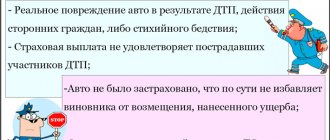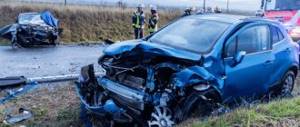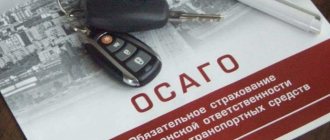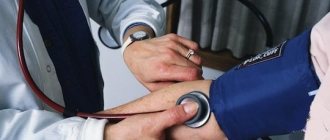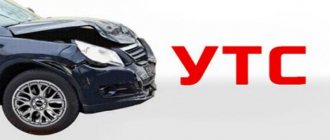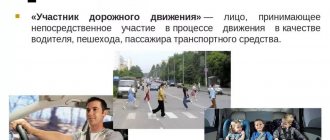Normative base
Analysis of any emergency situation, including one that occurred due to mutual fault, is carried out on the basis of the following regulations:
Attention! If you have any questions, you can chat for free with a lawyer at the bottom of the screen or call Moscow; Saint Petersburg; Free call for all of Russia.
- Provisions of the Civil Code of the Russian Federation (hereinafter referred to as the Civil Code of the Russian Federation);
- Provisions of the Code of the Russian Federation on Administrative Offenses (hereinafter referred to as the Code of Administrative Offenses of the Russian Federation);
- Requirements of the Federal Law of April 25, 2002 N 40-FZ “On compulsory insurance of civil liability of vehicle owners”;
- Articles of the Road Traffic Rules of the Russian Federation, approved by the Decree of the Government of the Russian Federation in the current edition (hereinafter referred to as the SDA);
- Departmental regulations, orders and instructions.
Definition of mutual guilt
Mutual fault in an accident is a largely controversial term and does not have a clear definition that would be enshrined in the Civil or Administrative Codes. However, as practice shows, traffic police officers and insurance companies often use this form of guilt when assessing an emergency situation. So, based on judicial practice, mutual guilt in an accident is a result of an incident in which each participant in one way or another violated traffic rules and is subject to legal liability in accordance with the Code of Administrative Offenses of the Russian Federation.
But, you need to know that, as such, a violation of traffic rules by a road user who is involved in an accident is not a direct basis for admitting mutual guilt. Thus, according to paragraph 2 of the Civil Code of the Russian Federation, compensation for damage occurs in proportion to the degree of guilt of the participants. In other words, if the violation is not related to the actual traffic accident, then the guilt is not recognized as mutual. Eg:
- The accident occurred due to the fact that one of the drivers drove through the intersection at a prohibitory signal. In this case, the second driver did not have the right to drive the vehicle. There is clearly a violation of the rules on the part of both. The first driver will be found guilty of the accident, since it was his violation that was the direct cause of the incident.
- The accident occurred because one driver entered the intersection from a secondary road and stopped to let people pass at the pedestrian crossing. However, the one who was driving along the main road significantly exceeded the speed limit and, approaching the intersection, did not have time to brake and crashed into the first one. In this case, the actions of both drivers may be classified as actions that directly led to the collision.
Degrees of guilt in a mutual accident
Accordingly, two degrees of guilt in a car accident are determined:
- Equal.
- Various.
Expert opinion
Maria Mirnaya
Insurance expert
OSAGO calculator
Determining the degree of fault is not within the competence of the insurer. This can only be done by a court on the basis of a protocol from a traffic police officer . The following case can be regarded as varying degrees of guilt: the first driver was driving without wearing a seat belt. The second driver, exceeding the speed limit, ran a red light and crashed into the first car. There are varying degrees of blame for the accident, although both drivers violated traffic rules.
When is it considered mutual fault in an accident?
Mutual guilt in road traffic accidents occurs in the following cases:
- The event of an accident is a consequence of circumstances in which it is not possible to accurately determine the degree of guilt of the participants. Most often this happens in traffic areas with unregulated conditions, for example, accidents in parking lots, parking lots, etc.
- The result of an accident is a combination of circumstances in which the guilt of the participants is determined exactly, and it is their mutual actions that caused the accident.
- Cases when all parties, when registering an accident, agreed with their mutual guilt.
In any case, the guilt of one or another traffic participant or their mutual guilt is determined by the court, which may not agree with the arguments of the traffic police officers who investigated the incident or the option in which the participants themselves admitted their mutual guilt in the accident.
Video on the topic of mutual guilt in an accident
| Question | Answer |
| Is it possible to prove the presence of mutual guilt in an accident if traffic police officers refuse to admit it? | It's possible. It is necessary to file a complaint with a higher traffic police department or go to court with a claim. It is required to provide evidence of an accident with mutual fault. In this case, the question of the presence or absence of mutual guilt is decided only by the court. |
| Can I count on payments under MTPL and CASCO if there is mutual fault in an accident? | Both parties have the right to count on this type of insurance compensation. Under compulsory motor liability insurance, they receive payments in equal shares or taking into account the degree of their culpability in the accident. Under CASCO, compensation does not depend on fault. It is paid based on the terms of the contract concluded with the insurer. |
| Is it possible to receive a payment under compulsory motor liability insurance for an accident with mutual fault in the absence of a policy? | The victim has the right to file a claim against the culprit through the court. Compensation will be made from the own funds of the person causing the damage. |
| Is it possible to draw up a European protocol in case of an accident with mutual fault, if three cars were involved in it? | A European protocol is only possible in case of an accident involving two cars, and in case of mutual fault, this document is not drawn up at all. If three cars collide at once, a traffic police call is required. |
| Is it possible to leave the scene of an accident with mutual fault if a person was injured during it? | The culprit of the accident can take the victim to a medical facility. But he must return to the scene of the incident. |
Comments Showing 0 of 0
Degrees of guilt
Even if a traffic accident occurred due to a violation by several traffic participants, the degree of involvement of each of them is determined. In this case, mutual fault in an accident can be:
- Equal.
This degree occurs when all road users contributed equally to the occurrence of the incident, taking into account the following mandatory conditions:
- Violation of traffic rules by each traffic participant.
- The presence of a direct connection between the violation committed by each participant and the incident event.
Consider a classic example: a car driven by a drunk driver crashes into another car driven by a sober driver. Both violated traffic rules, but the accident was caused by a sober driver. This means that the fault will not be recognized as mutual, and the drunk driver will be able to receive compensation for material damage and insurance payments. And only in the future, in accordance with Article 14 of Federal Law No. 40, the insurer, by way of a recourse claim, will demand compensation for the amount of insurance payments from the drunk driver.
- Equal severity of traffic violations committed. In order to determine equal severity, the number of violations of the provisions of the Traffic Rules and the severity of the punishment for them, which is provided for in the Code of Administrative Offences, are taken into account. If they are approximately equal, then the judge makes a decision on equal mutual guilt in the accident if the first two points are present.
- Various.
This degree is determined in cases where one of the participants violated the rules like the second, and both violations caused the accident, but the actions of the first were less gross than the second. When making a decision, the judge relies on the same conditions as when determining equal guilt. The fact is that there is simply no other method, and in some cases, even a highly professional expert will not be able to determine the degree of guilt of a particular driver in an accident.
A striking example of an accident with varying degrees of fault is the case when the driver of a faulty car, stopping on the side of the road, did not put up a warning sign and did not turn on the hazard warning lights. Another driver, moving in the same direction, significantly exceeding the set speed, without noticing a broken down car on the road, drives into it. Wherein:
- Both drivers violated the traffic rules that caused the accident: one did not set the required stop sign and did not turn on the hazard lights, and the second exceeded the speed limit, did not make sure that nothing was obstructing him and failed to avoid the accident.
- The violations of the first driver are less serious. After all, if the other participant in the accident had not exceeded the speed limit, then most likely he would have been able to avoid the collision.
Thus, any court will decide on various mutual faults in an accident.
Procedure for registering an accident
Step-by-step instructions for filing a mutual accident:
- Turn off the engine, put the car on the parking brake, turn on the warning lights and put up a warning triangle.
At night, on the roadway or side of the road, you must wear a jacket or cape vest with elements of reflective material that meet the requirements of GOST 12.4.281-2014. (Traffic rules clause 2.3.4)
- Call the traffic police, you can do this via the hotline.
- Try to find witnesses to the incident on your own, record the damage and the location of the cars with a camera, and if possible, ask other participants about the movement of video recordings.
- Upon arrival of the traffic police officers, tell them as fully as possible about the event and make sure that your words are accurately recorded in the protocol.
- Based on the circumstances of the accident, insist on your innocence.
If there is confidence that the collision was provoked by another participant, then you will have to go to court, where you will need to defend your position.
In case of minor damage to cars and no injuries, it will be possible to draw up a “Euro protocol” without calling the traffic police.
In cases where the traffic police inspector is involved in documenting the result of an accident, it is necessary to unobtrusively monitor his work, especially pay attention to the preparation of the following documents:
- Certificate of traffic accident for each participant.
- A protocol that should reflect:
- car layout;
- distances from reference points;
- description of damage;
- explanations from drivers and eyewitnesses.
- A resolution on the offense indicating a specific article of the Code of Administrative Offenses of the Russian Federation.
Instructions for filing an accident with mutual fault
If an accident occurs on the highway with mutual fault, you should follow the recommendations and act according to plan:
- Turn off the engine and secure the vehicle with the parking brake.
- Turn on the hazard warning lights.
- Install an emergency sign at the rear of the car. According to the requirements of clause 2.3.4. Traffic regulations, if a forced stop of the car occurred in the dark, then the driver is required to wear clothes with reflectors.
- It is recommended not to clear the roadway after an accident, even if there is an obstacle to the movement of other vehicles. Despite the fact that this violates clause 2.6.1. Traffic regulations and entails a fine of 1,000 rubles (under Part 1 of Article 12.27 of the Code of Administrative Offenses), an incident on the road with mutual fault always has an ambiguous nature. In the future, drivers may dispute mutual guilt, so it is necessary to leave the cars in their original position after an accident and call the traffic police. Fine under Part 1 of Art. 12.27 of the Code of Administrative Offenses can be challenged in the future (for example, citing the inability to start the car after an accident).
- Wait for the traffic police officers. After their arrival, the damage and the location of the vehicles are recorded.
IMPORTANT
Drivers do not have to fill out any documents, provided they have no claims against each other. In this case, a receipt must be drawn up. This document is necessary so that each party can subsequently protect itself from being called by another participant in an accident to the patrol service. The receipt will also prevent the parties from going to court. After drawing up the document, participants can legally leave the scene of the accident.
Damage compensation procedure
To an uninitiated person, it may seem that if an accident occurs due to mutual fault, then the participants in the accident do not pay each other anything, and guilt and repair costs seem to be balanced. However, this is a fundamentally wrong opinion. Paragraph 22 of Article 12 of the Federal Law “On Compulsory Insurance of Civil Liability of Vehicle Owners” states that insurance companies must pay money for damage caused in strict accordance with the degree of guilt of each participant in a traffic accident as determined by the judicial authorities.
If the degree of guilt cannot be determined even in court, then the insurance companies that insure the liability of drivers compensate for property damage in the event of an accident in equal amounts.
Similar requirements are contained in the Civil Code of the Russian Federation, and more specifically in Article 1083, which states that the amount of compensation is reduced in the presence of gross negligence of the victim, which provoked the incident.
Thus, payment of damages in case of an accident with mutual fault is made in the usual manner without providing additional documents and evidence. When assigning payments, the following circumstances are taken into account:
- in order to correctly calculate payments, the degree of culpability of the participants in the accident is taken into account;
- the basis for making payments is a court decision;
- if the judge was unable to determine the degree of guilt of the participants in the incident, then payments are made in equal shares.
Payments under compulsory motor liability insurance in case of mutual fault
In accordance with Article 12 of the so-called law “On Compulsory Motor Liability Insurance”, payments to victims in a road accident are made in proportion to the degree of guilt. And the degree of guilt is calculated in two values:
- Equal.
The most common variant of mutual fault in an accident. It is established either in court or in cases where the investigation of the incident did not reach the court. In such cases, each participant in the accident receives a payment equal to 50% of the damage caused to him.
An example of calculating equal payments is the following case: two cars were damaged in a traffic accident. Repairing the first one will cost 60 thousand rubles, repairing the second one will cost 30 thousand rubles. The court, having considered the circumstances of the accident, recognized the equal mutual guilt of both participants. In this case, the owner of the first car can count on payments in the amount of 30 thousand rubles, the owner of the second – 15 thousand rubles. You will have to find the missing funds yourself.
But there are cases when the damage caused to the car is so great that even the amount that the insurance company will pay to the owner exceeds the amount of insurance payments under normal circumstances. Here you can go to court and demand the necessary money from the participant in the accident. However, this can only be done in the amount of 50% of the total amount.
- Proportional to the guilt.
In cases where the court has determined that all participants are to blame for a road collision, only to varying degrees, then payments of insurance amounts will be proportional to the degree of guilt.
If we consider the previous example and accept that the court determined that the first driver was 10% at fault, and the second 90% at fault, then payments will be made in the following amounts:
- the first driver will receive 54 thousand rubles;
- the second - 3 thousand rubles.
How payments are calculated and made
In accordance with paragraph 22 of Art. 12 of the Law on OSAGO, compensation is paid in an amount proportional to the degree of guilt of each car owner. Participants in an accident can receive either equal or different amounts.
Equal amounts
This type of compensation is used when it is proven that both drivers are equally to blame for the accident. Signs of such a situation are the following facts:
- non-compliance with the rules by every motorist;
- connection of actions that do not comply with traffic rules with the incident;
- The severity of each violation is approximately the same.
The last paragraph takes into account the number of rules violated, as well as the amount of penalties established for each of them. It is this option for determining the mutual guilt of drivers that is most often used by judicial authorities.
By analyzing the submitted documents, it is established which rules were not followed. If the number of violations and the degree of punishment for them are approximately the same, mutual guilt of motorists is recognized to an equal degree.
Various amounts
This option is used much less frequently, only when it is really possible to prove different degrees of guilt by studying the case materials.
Example. One motorist was driving a faulty vehicle and stopped on the highway. However, he did not turn on the emergency lights and did not put up a sign. Another driver was driving at a speed higher than the speed limit and hit a stationary car, causing harm not only to the car, but also to the person in it.
In such a situation, it can be established that:
- both car owners are guilty of what happened - one exceeded the speed limit, and the second violated the emergency stop rules;
- The guilt of the first driver is less significant - if the second one had moved at the required speed, he would have had time to react to the broken car even without a stop sign.
Compensation calculation
In accidents in which both participants are at fault, when calculating compensation, the key factor is not the amount of damage, but the degree of fault of each driver.
So, compensation for damage is made in one of two ways.
- 50/50 – if the parties decided not to file a statement of claim or if the court decided that their guilt was the same. In this situation, each driver will receive half the amount of established damage. For example, two cars were damaged. The expert estimated the amount of damage to one of them at 60 thousand rubles, and the other at 70 thousand rubles. In this case, the first driver will receive 30 thousand rubles, and the second – 35 thousand rubles.
- According to the degree of guilt. If there is a court ruling on the unequal degree of guilt of the participants in the accident, the insurance company makes payments based on the ratio established by Themis. Let's say the expert assessed the size of the damage in the same way as in the previous example. In case of another court decision (the fault of the first car owner is 10%, and the second – 90%), the first will be paid 54 thousand rubles, and the second only 7 thousand rubles.
Payment under CASCO in case of mutual fault
The specifics of payments to drivers under CASCO insurance are determined by the specific provisions of the insurance contract. If a road traffic accident with mutual fault falls under the terms of insurance and there are no reasons for denial, then the entire insured amount will be paid in full. The insurance company is not interested in whether the victim is at fault.
The grounds for refusal to pay funds must be clearly stated in the contract. If the insurer fails to comply with its obligations, the driver has the right to seek help from the court.
Mutual fault in an accident with victims
If in a traffic accident that occurred due to mutual fault there are injuries or even deaths, then, depending on the severity of the harm to health, the drivers responsible for the incident will face administrative or criminal liability.
In accordance with the provisions of the Plenum of the Supreme Court of the Russian Federation No. 25 of June 23, 2015, administrative or criminal liability, including imprisonment, will be borne by both participants in the road accident.
- For harm caused to oneself, you will not have to bear punishment, but the other culprit of the accident will be held accountable depending on the degree of guilt.
- Both drivers responsible for the accident will be responsible for harm caused to an unauthorized participant or passenger in a mutual accident.
Appeal against mutual guilt
For a driver who is found guilty of an accident, adverse consequences occur, expressed in compensation for material damage and execution of punishment. Sometimes, when an accident is recognized as a mutual accident, situations arise when one of the participants considers himself to be unreasonably accused. The optimal way to restore legality for such a driver is to challenge the guilt.
It is worth noting that a participant in a traffic accident is found guilty in the case where there is a stable cause-and-effect relationship between the traffic violation and the accident.
The procedure for appealing against mutual fault in an accident is relevant in the following cases:
- Disagreement of the participant in the accident with the act, which contains conclusions regarding the violation of the rules.
- Lack of a clear cause-and-effect relationship between traffic violations and road accidents.
- Violation of procedural rules and requirements by the person who makes a decision in the case.
The appeal itself can take place in the following order:
- Pre-trial - through a complaint to higher authorities of the traffic police.
- Through the court.
- In civil proceedings.
An appeal against guilt can occur with the aim of assigning mutual guilt in an accident.
Regulatory framework and the concept of mutual guilt
To be honest, inspectors don’t really like situations where both are to blame. This is understandable - you need to fill out twice as many documents, understand the situation more carefully, but there is little time, there is a lot of work.
For this reason, it is easier for law enforcement officers to draw up a protocol and a resolution for the driver whose violation is more obvious and fits the standard situations established in judicial practice.
The law does not contain a special term to which this article is devoted. The concept under consideration has practical application. It denotes a situation where a traffic accident was caused by violations of traffic rules by all participants in the accident.
From a conceptual point of view, the word “mutual” is not entirely correct, because participants in an accident can be not only two, but three or more drivers, each of whom may be at fault.
In such a situation, decisions should be issued not for two, but for all the culprits. Here it is absurd to use the phrase “mutual guilt in an accident” when there are more than two culprits, although its meaning will be implied.
Legal regulation
Due to the absence of a special norm dedicated to the “rim”, situations related to it are subject to regulation by general norms related to road accidents.
The list of regulatory legal acts includes:
- Traffic Laws.
- Law on compulsory motor liability insurance.
- Civil Code of the Russian Federation.
- Code of Administrative Offenses of the Russian Federation.
Depending on who violated what, the corresponding article of the traffic rules and the norm containing sanctions for an administrative offense are determined.
Next, the rules on compulsory motor liability insurance come into play, which should be followed when interacting with insurance companies. You should also pay special attention to the procedural norms of the Code of Civil Procedure of the Russian Federation applicable in cases of judicial challenge.
When fault in an accident is recognized as mutual
The conclusion about mutual guilt is made in the case when traffic violations that resulted in an accident were committed not by one, but by both drivers.
The “both-fault” category also includes accidents with more than two at-fault participants. A prerequisite for mutual guilt is the established fact of a violation of traffic rules that resulted in an accident.
The important point is that just the fact of a violation is not enough. Not all violations can cause an accident. Therefore, a necessary condition for the recognition of “wrongdoing” is a cause-and-effect relationship between such a violation and an accident.
Examples of judicial practice
Judicial practice is replete with cases in which road traffic accidents that occurred due to mutual fault are considered.
- In April 2021, the Volzhsky District Court of Samara issued a conclusion in the case of compensation for damage after an accident due to mutual fault. One driver of the vehicle violated the rules for driving through intersections, and the second exceeded the speed limit. The driver who exceeded the speed did not agree with mutual guilt, in which responsibility is imposed in equal shares, and demanded that the blame be distributed in proportions of 10 to 90%. The driver who violated the rules for driving through the intersection, based on expert opinions, was able to prove in court that if the second driver had not exceeded the speed limit, he would have been able to avoid the accident. As a result, the court left the decision on mutual guilt in equal shares unchanged.
- In July 2021, the Sovetsky District Court of Tula issued an opinion on the following case. The accident that occurred in early 2017 involved a driver who failed to give way to a vehicle moving on the main road. The fact that indicated that the car on the main road was moving at a significant speed limit was not taken into account by the traffic police officers. After all the insurance settlements had been made, the victim filed a lawsuit to recover from the culprit the funds needed to repair the car. However, in court, the culprit of the accident presented data that indicated that the victims were speeding, after which the court decided to recognize the accident as a mutual fault and reduce the amount of recovery by half.
Practice in similar cases in courts
There are many examples of court decisions regarding mutual fault in road accidents.
Two similar cases were considered by the district courts of St. Petersburg and Samara. In both cases, one of the drivers tried to dispute equal mutual fault in the accident. There was an attempt to reclassify it as different and reduce the amount of damage payments. In both cases, one of the drivers violated traffic rules while driving through the intersection, and the second one violated the rules regarding speeding.
The persons were found mutually guilty of the accident and received compensation from insurers in the amount of 50:50. Drivers who violated the speed limit disputed the amount of compensation. One appealed to the Leninsky Court of St. Petersburg with a demand to assign him a payment of 75%, and the second culprit - 25%. Another filed an application with the Volzhsky Court of Samara for compensation of 90% instead of the previously established 50%.
In both cases, drivers who violated traffic rules while crossing intersections brought in experts to review the case. They were able to prove that it was the speeding of the second drivers that was the main cause of the incident. Both the Leninsky and Volzhsky courts agreed with the experts’ conclusions, leaving the previous decisions in force.
In Tula in 2021 and in Orel in 2015, similar cases were considered regarding the incorrect determination of general guilt by traffic police officers. In both cases, traffic violations committed by the victims were not taken into account. Those responsible for the accident went to court because they were not satisfied with the amount of compensation under compulsory motor liability insurance. Another driver from Tula also disputed the victim’s claim for additional recovery of funds from him for car repairs. In both cases, the drivers were able to prove the fact of mutual guilt along with the victims. The plaintiffs presented transcripts of data from video recording cameras installed on the highways, which revealed that the victims were speeding. However, this information was not taken into account by traffic police officers when drawing up protocols and decisions. The courts recognized mutual guilt and reduced the amount of compensation for damage by half.
Some nuances
- Registration of the European protocol.
The question often arises: is it possible to issue a European protocol if both participants in the accident are at fault? In accordance with Article 12 of the Law “On Compulsory Motor Liability Insurance” and the provisions of the Plenum of the Supreme Court of the Russian Federation No. 25 of June 23, 2015, payments for mutual fault are made in equal shares, unless the court establishes a proportional ratio of fault. In addition, no documents from the traffic police are required to make insurance payments.
Thus, if an accident occurs, you can use the European protocol, but only in cases where both participants admit their own guilt and there are no disputes between them.
- Is it possible to leave the scene of an accident if it is both at fault?
In accordance with the traffic rules of the Russian Federation, it is possible to leave the scene of a traffic accident in cases where a European protocol has been drawn up or when a diagram of the accident has been drawn up and both drivers have gone to the nearest traffic police station for further registration.
In all other cases, leaving the scene of an accident without good reason entails administrative liability, up to and including deprivation of the right to drive a vehicle, regardless of the degree of guilt.
Is it possible to fill out a European protocol during a “reciprocation”?
Issues of insurance and compensation are regulated by the Federal Law on Compulsory Motor Liability Insurance and the Insurance Rules approved by the Bank of Russia. And both of them do not contain clear formulations regarding our question:
- the legislation does not directly prohibit drawing up a European protocol if the fault of the participants in the accident is mutual,
- at the same time, you will not find anywhere that it is directly stated that this is permitted in the case of mutual relations.
However, there is an exhaustive list of conditions when an accident can be registered without traffic police officers, and this is regulated by Article 11.1 of the Federal Law on Compulsory Motor Liability Insurance in its very first paragraph:
- damage was caused only to cars (no injured people or other property),
- two participants - no less and no more,
- both have MTPL policies,
- there are no disagreements regarding the circumstances and visible damage (except for cases when the accident is recorded using GLONASS or the Road Accident.Europrotocol application), and this is all recorded in the notice.
As you can see, nothing is said about mutual guilt. And this directly means that the legislation today does not prohibit this. Although, in practice there are unlawful refusals.
A European protocol can be drawn up if the participants in an accident are mutually at fault, but this must be reflected in the notification form.
In one of the previous articles, we said that it is best to write the guilt directly in the notice. And in the case of marriage, this is also necessary. But how to indicate this correctly?

